Hyundai Elantra 2009 Инструкция по эксплуатации (in Russian)
Manufacturer: HYUNDAI, Model Year: 2009, Model line: Elantra, Model: Hyundai Elantra 2009Pages: 308, PDF Size: 15.03 MB
Page 251 of 308

Maintenance
26
7
3. Remove the climate control air filter
case pulling out the cover. 4. Replace the climate control air filter.
5. Reassemble in the reverse order of
disassembly.
✽✽ NOTICE
When replacing the climate control air
filter install it according to the “AIRFLOW �È
�È
” and “ �Ç�Ç
UP” identification
marks. Otherwise, the system may pro- duce noise and the effectiveness of the
filter may be reduced.
OHD076022ROHD076023
Page 252 of 308
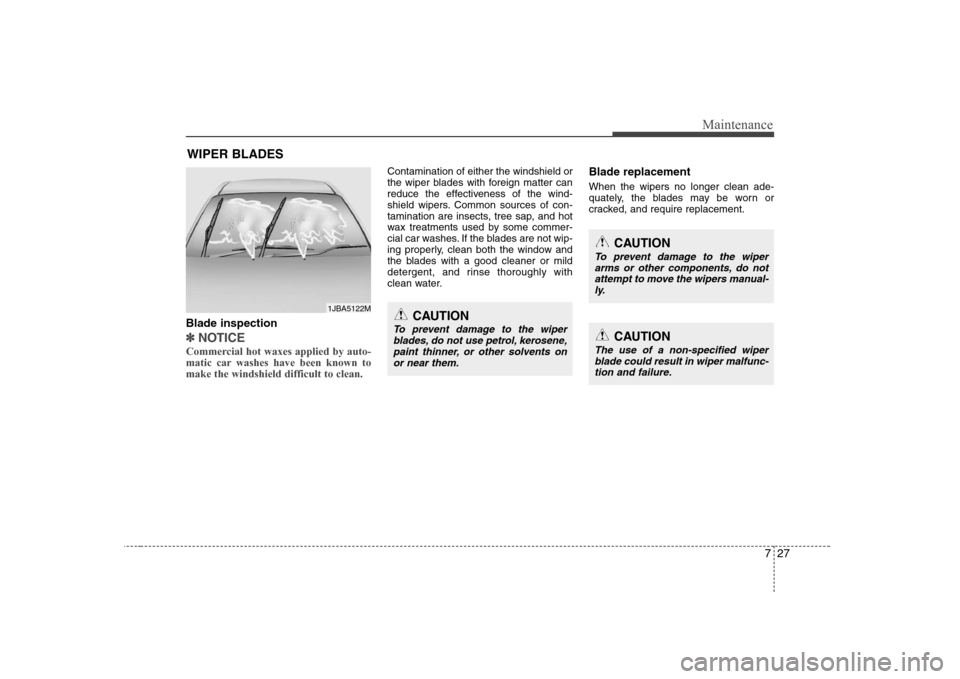
727
Maintenance
WIPER BLADES
Blade inspection
✽✽ NOTICE
Commercial hot waxes applied by auto-
matic car washes have been known tomake the windshield difficult to clean.
Contamination of either the windshield or
the wiper blades with foreign matter can
reduce the effectiveness of the wind-
shield wipers. Common sources of con-
tamination are insects, tree sap, and hot
wax treatments used by some commer-
cial car washes. If the blades are not wip-
ing properly, clean both the window and
the blades with a good cleaner or mild
detergent, and rinse thoroughly with
clean water. Blade replacement When the wipers no longer clean ade-
quately, the blades may be worn or
cracked, and require replacement.
1JBA5122MCAUTION
To prevent damage to the wiper
blades, do not use petrol, kerosene,
paint thinner, or other solvents onor near them.
CAUTION
To prevent damage to the wiper
arms or other components, do notattempt to move the wipers manual- ly.
CAUTION
The use of a non-specified wiper
blade could result in wiper malfunc-tion and failure.
Page 253 of 308
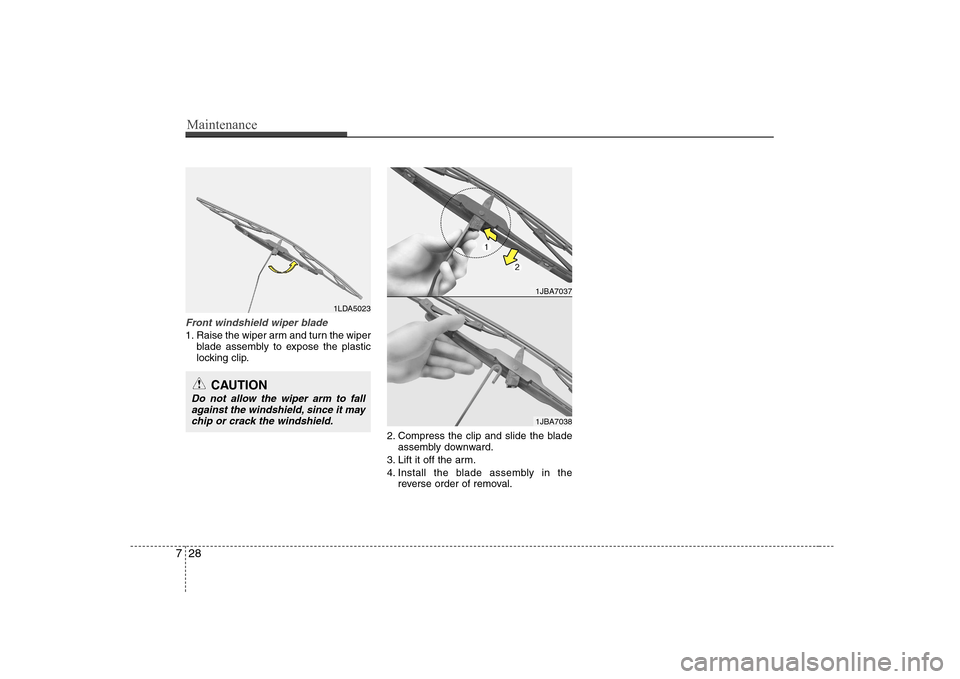
Maintenance
28
7
Front windshield wiper blade
1. Raise the wiper arm and turn the wiper
blade assembly to expose the plastic
locking clip.
2. Compress the clip and slide the bladeassembly downward.
3. Lift it off the arm.
4. Install the blade assembly in the reverse order of removal.
1LDA5023
CAUTION
Do not allow the wiper arm to fall
against the windshield, since it may
chip or crack the windshield.
1JBA7037
1JBA7038
Page 254 of 308
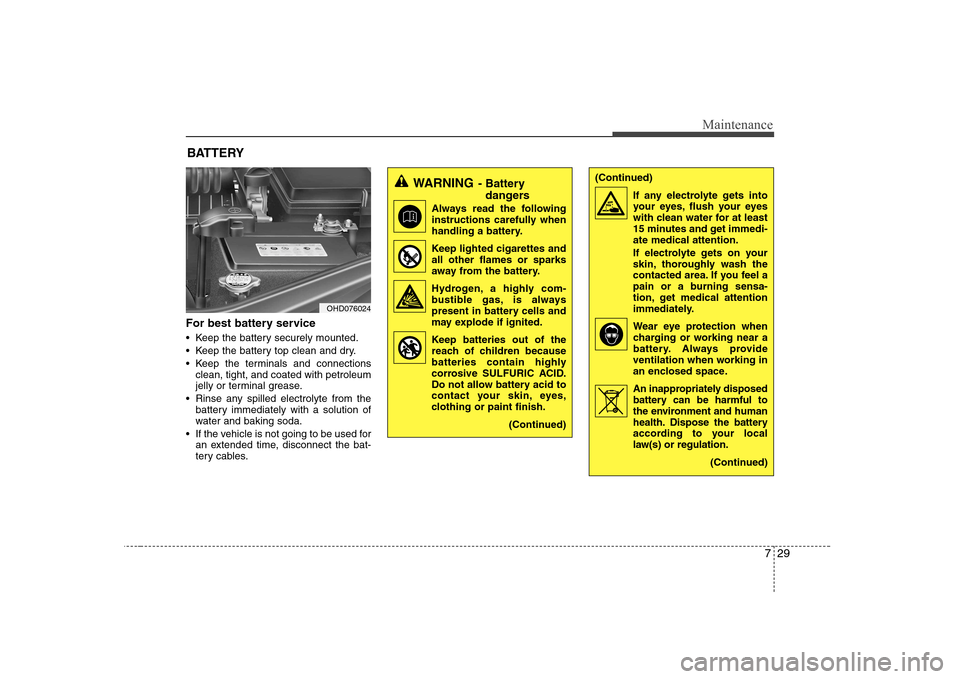
729
Maintenance
For best battery service
Keep the battery securely mounted.
Keep the battery top clean and dry.
Keep the terminals and connectionsclean, tight, and coated with petroleum
jelly or terminal grease.
Rinse any spilled electrolyte from the battery immediately with a solution of
water and baking soda.
If the vehicle is not going to be used for an extended time, disconnect the bat-
tery cables.
WARNING - Battery
dangers
Always read the following
instructions carefully when
handling a battery.
Keep lighted cigarettes and all other flames or sparks
away from the battery.
Hydrogen, a highly com- bustible gas, is always
present in battery cells and
may explode if ignited.
Keep batteries out of the
reach of children because
batteries contain highly
corrosive SULFURIC ACID.
Do not allow battery acid to
contact your skin, eyes,
clothing or paint finish.
(Continued)(Continued)If any electrolyte gets intoyour eyes, flush your eyes
with clean water for at least
15 minutes and get immedi-ate medical attention.
If electrolyte gets on your
skin, thoroughly wash the
contacted area. If you feel a
pain or a burning sensa-
tion, get medical attention
immediately.
Wear eye protection when charging or working near a
battery. Always provide
ventilation when working in
an enclosed space.
An inappropriately disposed battery can be harmful to
the environment and human
health. Dispose the battery
according to your local
law(s) or regulation.
(Continued)
BATTERY
OHD076024
Page 255 of 308
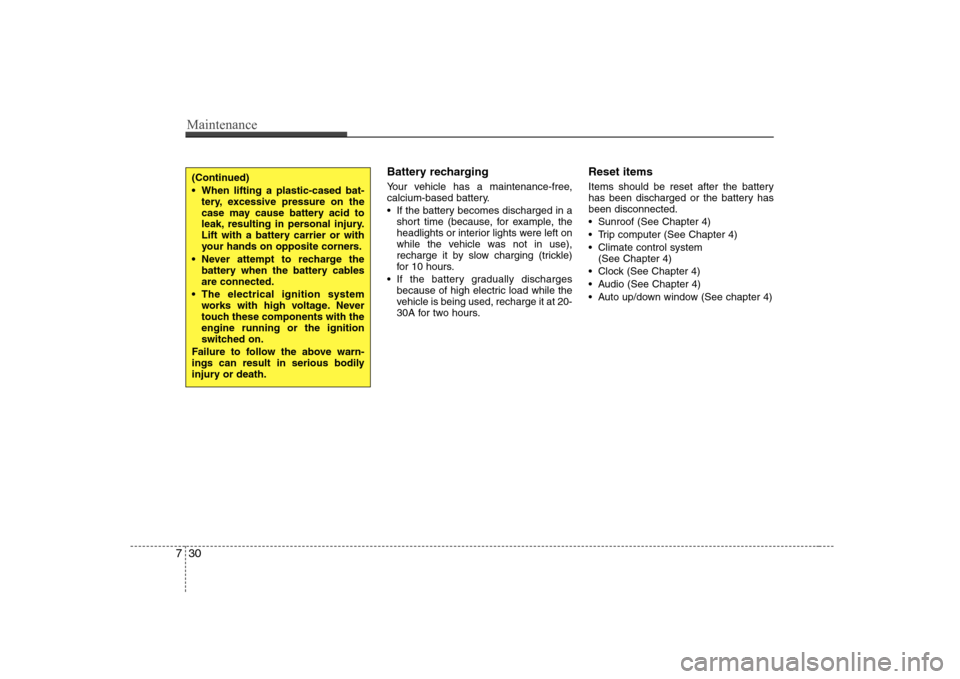
Maintenance
30
7
Battery recharging
Your vehicle has a maintenance-free,
calcium-based battery.
If the battery becomes discharged in a
short time (because, for example, the
headlights or interior lights were left on
while the vehicle was not in use),
recharge it by slow charging (trickle)
for 10 hours.
If the battery gradually discharges because of high electric load while the
vehicle is being used, recharge it at 20-
30A for two hours. Reset items
Items should be reset after the battery
has been discharged or the battery hasbeen disconnected.
Sunroof (See Chapter 4)
Trip computer (See Chapter 4)
Climate control system
(See Chapter 4)
Clock (See Chapter 4)
Audio (See Chapter 4)
Auto up/down window (See chapter 4)(Continued)
When lifting a plastic-cased bat- tery, excessive pressure on the
case may cause battery acid to
leak, resulting in personal injury.
Lift with a battery carrier or with
your hands on opposite corners.
Never attempt to recharge the battery when the battery cablesare connected.
The electrical ignition system works with high voltage. Never
touch these components with theengine running or the ignition
switched on.
Failure to follow the above warn-
ings can result in serious bodily
injury or death.
Page 256 of 308
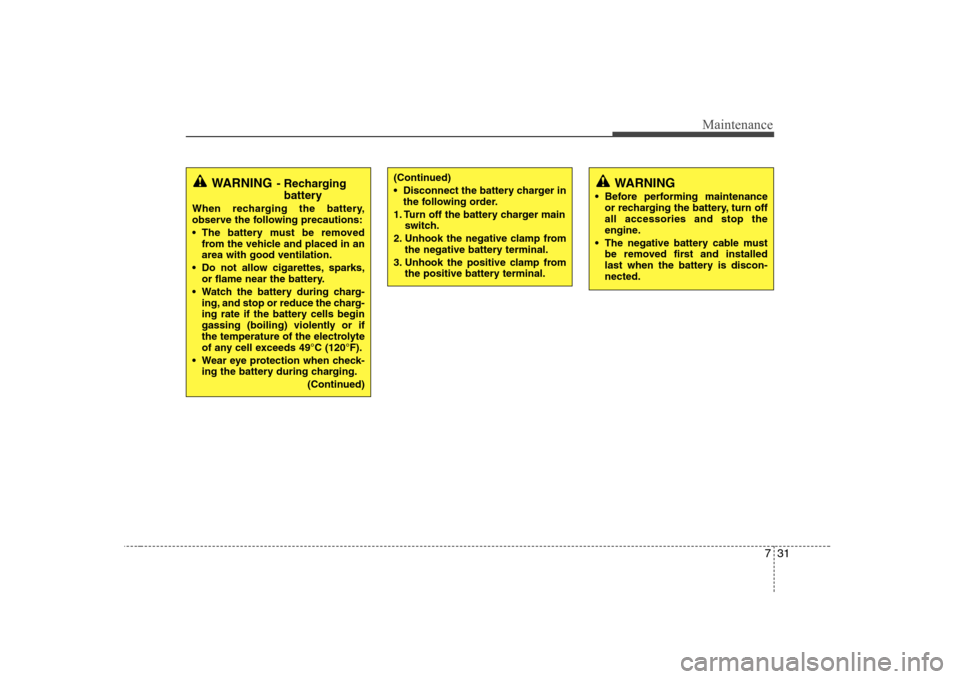
731
Maintenance
WARNING- Recharging
battery
When recharging the battery,
observe the following precautions:
The battery must be removed from the vehicle and placed in an area with good ventilation.
Do not allow cigarettes, sparks, or flame near the battery.
Watch the battery during charg- ing, and stop or reduce the charg-
ing rate if the battery cells begin
gassing (boiling) violently or if
the temperature of the electrolyte
of any cell exceeds 49°C (120°F).
Wear eye protection when check- ing the battery during charging.
(Continued)(Continued)
Disconnect the battery charger inthe following order.
1. Turn off the battery charger main switch.
2. Unhook the negative clamp from the negative battery terminal.
3. Unhook the positive clamp from the positive battery terminal.WARNING
Before performing maintenance or recharging the battery, turn off all accessories and stop the
engine.
The negative battery cable must be removed first and installed
last when the battery is discon-nected.
Page 257 of 308
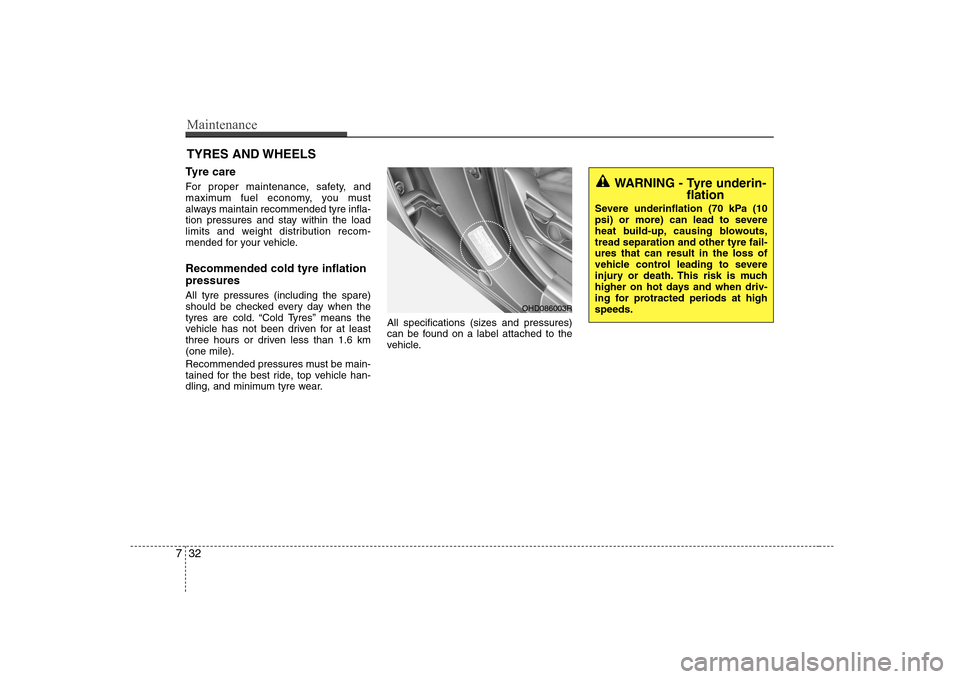
Maintenance
32
7
TYRES AND WHEELS
Tyre care
For proper maintenance, safety, and
maximum fuel economy, you must
always maintain recommended tyre infla-
tion pressures and stay within the load
limits and weight distribution recom-
mended for your vehicle. Recommended cold tyre inflation pressures All tyre pressures (including the spare)
should be checked every day when the
tyres are cold. “Cold Tyres” means the
vehicle has not been driven for at least
three hours or driven less than 1.6 km(one mile).
Recommended pressures must be main-
tained for the best ride, top vehicle han-
dling, and minimum tyre wear. All specifications (sizes and pressures)
can be found on a label attached to the
vehicle.
WARNING - Tyre underin-
flation
Severe underinflation (70 kPa (10
psi) or more) can lead to severe
heat build-up, causing blowouts,tread separation and other tyre fail-ures that can result in the loss of
vehicle control leading to severe
injury or death. This risk is much
higher on hot days and when driv-
ing for protracted periods at highspeeds.
OHD086003R
Page 258 of 308
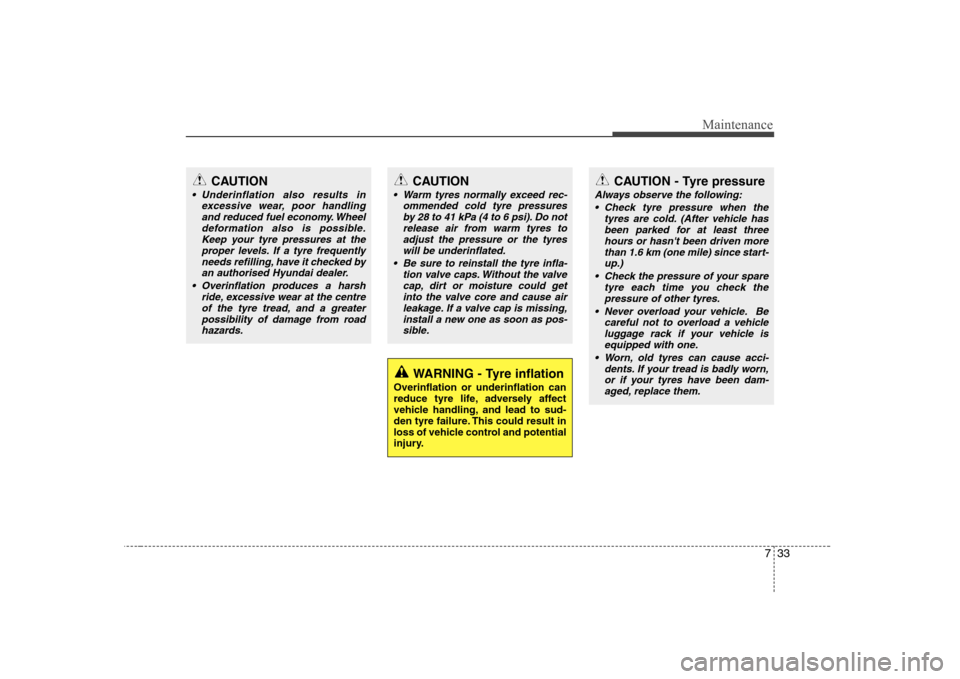
733
Maintenance
WARNING - Tyre inflation
Overinflation or underinflation can
reduce tyre life, adversely affect
vehicle handling, and lead to sud-
den tyre failure. This could result in
loss of vehicle control and potential
injury.
CAUTION - Tyre pressure
Always observe the following:
Check tyre pressure when the tyres are cold. (After vehicle hasbeen parked for at least threehours or hasn't been driven more
than 1.6 km (one mile) since start- up.)
Check the pressure of your spare tyre each time you check thepressure of other tyres.
Never overload your vehicle. Be careful not to overload a vehicleluggage rack if your vehicle is equipped with one.
Worn, old tyres can cause acci- dents. If your tread is badly worn,or if your tyres have been dam- aged, replace them.
CAUTION
Underinflation also results in
excessive wear, poor handlingand reduced fuel economy. Wheeldeformation also is possible.
Keep your tyre pressures at theproper levels. If a tyre frequentlyneeds refilling, have it checked byan authorised Hyundai dealer.
Overinflation produces a harsh ride, excessive wear at the centreof the tyre tread, and a greaterpossibility of damage from road
hazards.
CAUTION
Warm tyres normally exceed rec- ommended cold tyre pressuresby 28 to 41 kPa (4 to 6 psi). Do notrelease air from warm tyres to
adjust the pressure or the tyres will be underinflated.
Be sure to reinstall the tyre infla- tion valve caps. Without the valvecap, dirt or moisture could get
into the valve core and cause air leakage. If a valve cap is missing,install a new one as soon as pos-
sible.
Page 259 of 308
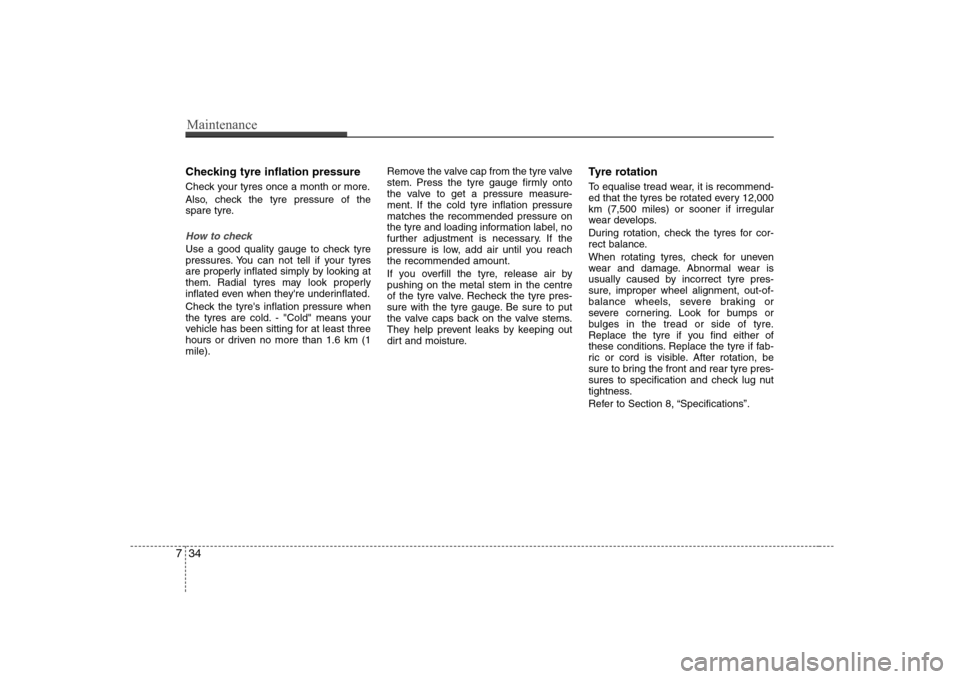
Maintenance
34
7
Checking tyre inflation pressure
Check your tyres once a month or more.
Also, check the tyre pressure of the
spare tyre.
How to check
Use a good quality gauge to check tyre
pressures. You can not tell if your tyres
are properly inflated simply by looking at
them. Radial tyres may look properly
inflated even when they're underinflated.
Check the tyre's inflation pressure when
the tyres are cold. - "Cold" means your
vehicle has been sitting for at least three
hours or driven no more than 1.6 km (1mile). Remove the valve cap from the tyre valve
stem. Press the tyre gauge firmly onto
the valve to get a pressure measure-
ment. If the cold tyre inflation pressurematches the recommended pressure on
the tyre and loading information label, no
further adjustment is necessary. If the
pressure is low, add air until you reachthe recommended amount.
If you overfill the tyre, release air by pushing on the metal stem in the centre
of the tyre valve. Recheck the tyre pres-
sure with the tyre gauge. Be sure to put
the valve caps back on the valve stems.
They help prevent leaks by keeping out
dirt and moisture.
Tyre rotation
To equalise tread wear, it is recommend-
ed that the tyres be rotated every 12,000km (7,500 miles) or sooner if irregular
wear develops.
During rotation, check the tyres for cor-
rect balance.
When rotating tyres, check for uneven
wear and damage. Abnormal wear is
usually caused by incorrect tyre pres-
sure, improper wheel alignment, out-of-
balance wheels, severe braking or
severe cornering. Look for bumps or
bulges in the tread or side of tyre.
Replace the tyre if you find either of
these conditions. Replace the tyre if fab-
ric or cord is visible. After rotation, be
sure to bring the front and rear tyre pres-
sures to specification and check lug nut
tightness.
Refer to Section 8, “Specifications”.
Page 260 of 308
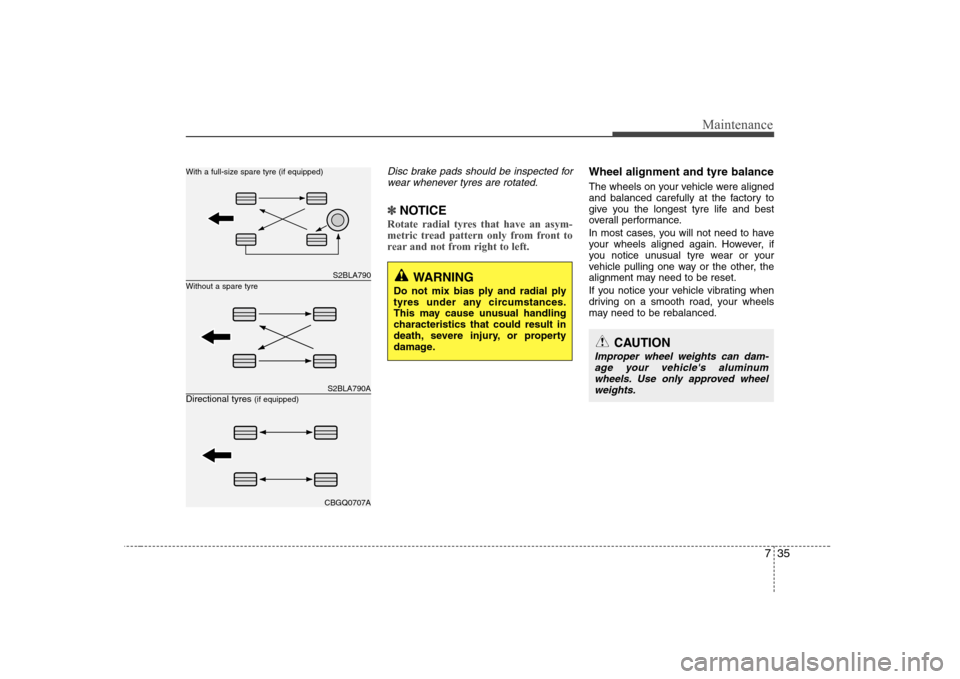
735
Maintenance
Disc brake pads should be inspected forwear whenever tyres are rotated.
✽✽NOTICE
Rotate radial tyres that have an asym-
metric tread pattern only from front to
rear and not from right to left.
Wheel alignment and tyre balance
The wheels on your vehicle were aligned
and balanced carefully at the factory to
give you the longest tyre life and best
overall performance.
In most cases, you will not need to have
your wheels aligned again. However, if
you notice unusual tyre wear or your
vehicle pulling one way or the other, the
alignment may need to be reset.
If you notice your vehicle vibrating when
driving on a smooth road, your wheels
may need to be rebalanced.
WARNING
Do not mix bias ply and radial ply
tyres under any circumstances.
This may cause unusual handling
characteristics that could result in
death, severe injury, or property
damage.S2BLA790
S2BLA790A
CBGQ0707A
Without a spare tyre
With a full-size spare tyre (if equipped) Directional tyres
(if equipped)
CAUTION
Improper wheel weights can dam-
age your vehicle's aluminumwheels. Use only approved wheel
weights.